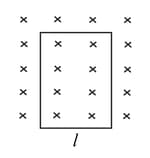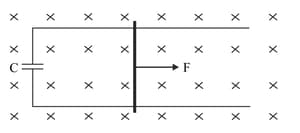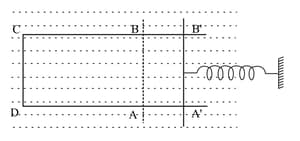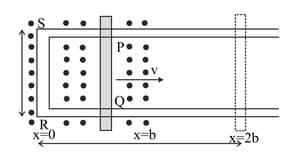Figure 6.88 shows a long, rectangular, conducting loop of width , mass and resistance placed partly in a perpendicular magnetic field . With what velocity should it be pushed downwards so that it may continue to fall without any acceleration?



Important Questions on Electromagnetic Induction
Figure 6.89 shows a wire of mass m and length which can slide on a pair of parallel, smooth, horizontal rails placed in a vertical magnetic field . The rails are connected by a capacitor of capacitance . The electric resistance of the rails and the wire is zero. If a constant force F acts on the wire as shown in the figure, find the acceleration of the wire.

A rectangular wire frame, as shown in Fig. 6.90(a) is placed in uniform magnetic field directed upward and normal to the plane of the paper. The part is connected to a spring. The spring is stretched and released when the wire has come to the position . Explain qualitatively how induced emf in the coil would vary with time. Neglect damping of oscillations of the spring.

Figure 6.91 shows two long coaxial solenoids, each of length ''. The outer solenoid has an area of cross-section and number of turns/length . The corresponding values for the inner solenoid are and . Write the expression for self inductance , of the two coils and their mutual inductance . Hence show that .

The magnetic flux passing perpendicular to the plane of a coil and directed into the paper is given by , where is in milliwebers and in seconds.
What is the direction of current through the resistor ?
A square metal wire loop of side and resistance is moved with a constant velocity in a uniform magnetic field of induction as shown in Fig. 6.94. The magnetic lines are perpendicular to the plane of the loop (directed into the paper). The loop is connected to a network of resistors each of value . The resistances of the loop wires and are negligible. What should be the speed of the loop so as to have a steady current of in the loop? Give the direction of the current in the loop?

Refer to Fig. 6.95. The arm of the rectangular conductor is moved from to the right side. The uniform magnetic field is perpendicular to the plane and extends from to and is zero for . Only the arm possesses substantial resistance . Consider the situation when the arm is pulled outwards from to and is then moved back to with constant speed . Obtain expressions for the flux, the induced emf, the force necessary to pull the arm and the power dissipated as Joule heat. Sketch the variation of these quantities with time.

